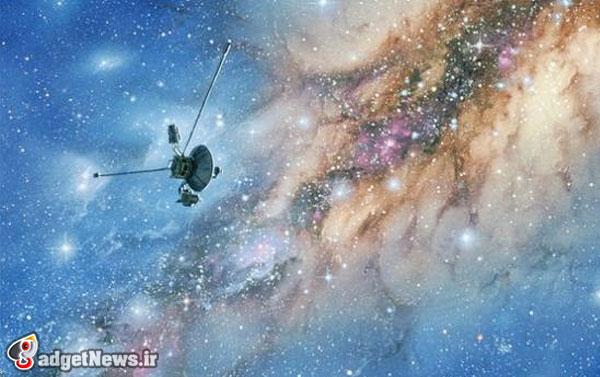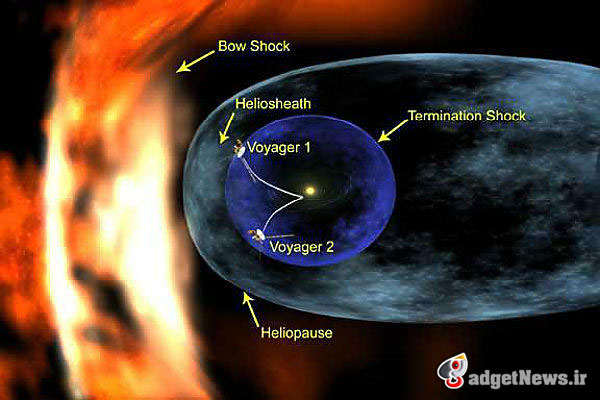
دانشمندان دانشگاههای مریلند و بوستون بر این ادعا هستند که فضاپیمای وویجر 1 بیش از یکسال قبل از منظومه شمسی خارج و وارد فضای میان ستارهای شده است.این در حالیست که ناسا معتقد است این فضاپیما هنوز در یک منطقه انتقال تقریبا ناشناخته بین حوزه نفوذ خورشید و سایر کهکشان قرار دارد.
وویجر 1 که به همراه خود پیامهای زمینی را بر روی یک صفحه گرامافون با روکش طلا داشته، تاکنون بیشتر از تمام اجسام ساخت دست بشر از زمین دور شده است.ماموریت کنونی آن در کنار فضاپیمای وویجر 2 کشف بیرونیترین لبه منطقه نفوذ خورشید و ورای آن است.
اکنون دانشمندان مریلند و بوستون اظهار کردهاند که این فضاپیما اولین اکتشافات کهکشان راه شیری در خارج از منطقه تاثیر خورشید را آغاز کرده است. اگرچه گزارش ناسا در مقایسه چنین نتیجهگیری کرده که وویجر 1 هنوز در مرزهای نهایی منظومه شمسی است.این محققان مدلی از لبه خارجی هلیوسفر را ساختهاند که نشان میدهد وویجر 1 در حقیقت کمی بیشتر از یکسال قبل وارد فضای میان ستارهای شده است.
مشکل اینجاست که دانشمندان دقیقا نمیدانند این فضاپیما چه مسافتی را باید طی کند تا به فضای میان ستارهای برسد.در واقعیت، هیچ مرز مشخصی وجود ندارد که محدوده منظومه شمسی در فاصله 17.7 میلیارد کیلومتری را تعریف کند.منطقه هلیوسفر تقریبا به عنوان منطقهای از فضا که تحت تاثیر میدان مغناطیسی و ذرات باردار خورشیدی قرار داشته، شناخته شده است.در خارج از هلیوسفر، فضای میانستارهای پر از ماده ستارگان دیگر و میدان مغناطیسی حاضر در منطقه نزدیک کهکشان راهشیری است.طبق خرد متعارف، دانشمندان زمانی خواهند دانست که وویجر از این مرز اسرارآمیز رد شده که دیگر ذرات خورشیدی را ندیده و ذرات کهکشانی را مشاهده کنند.همچنین جهت غالب میدان مغناطیسی محلی با تغییراتی روبرو خواهد شد.

مشکل اینجاست که ناسا بر این باور است که جهت میدانهای مغناطیسی در حباب خورشیدی در یک الگوی مختلف جهتی نسبت به میدانهای موجود در فضای میانستارهای حرکت میکنند.دانشگاه مریلند استدلال کرده که میدانهای مغناطیسی داخل و خارج حباب خورشیدی در یک جهت مشابه هستند.به ادعای این دانشمندان، از این رو منطقهای وجود داشته که حباب خورشیدی و فضای میانستارهای در آن همپوشانی دارد و در نتیجه حدود منظومه شمسی نزدیکتر بوده و وویجر تاکنون از آن گذشته است.
فضاپیماهای وویجر 1 و 2 که در سال 1977 به فضا ارسال شده بودند، با استفاده از طیف گسترده تجهیزات خود به ارائه دادههای علمی میپردازند و از نیروی کافی برای اجرایی ماندن تا سال 2020 برخوردارند.
منبع : space
Voyager 1 Spacecraft Left Solar System Last Year, Study Suggests
While the handlers of NASA's venerable Voyager 1 spacecraft are still waiting for it to depart the solar system, a new study argues that the probe actually popped free into interstellar space last year.
Voyager 1 left the sun's sphere of influence on July 27, 2012, according to the study, which employs a new model to explain and interpret the probe's data. The new model is different from NASA's take, which suggests Voyager 1 remains within the solar system, though just barely.
"It's a somewhat controversial view, but we think Voyager [1] has finally left the solar system, and is truly beginning its travels through the Milky Way," lead author Marc Swisdak of the University of Maryland said in a statement. [NASA's Voyager Probes: 5 Surprising Facts]
Swisdak and co-authors James Drake and Merav Opher — of the University of Maryland and Boston University, respectively — are not Voyager mission scientists. Their findings contrast with recent papers by the mission team and other researchers, which have concluded that the spacecraft is likely plying a strange transition zone at the edge of the solar system.
A long journey
Infographic: unmanned Voyager 1 and 2 probes visited the outer planets of the solar system and are approaching the edge of our solar system.
The unmanned Voyager 1 and 2 probes were launched in 1977 on a mission to visit all the outer planets of the solar system. After 35 years in space, the twin probes are approaching the edge of our solar system. [See how the Voyager spacecraft worked in this SPACE.com infographic here]
Credit: Karl Tate, SPACE.com
View full size image
Voyager 1 and its twin, Voyager 2, launched a few weeks apart in 1977 to study Saturn, Jupiter, Uranus and Neptune. The duo completed this "grand tour" and then kept right on flying toward interstellar
Voyager 1 will get there first. It's about 11.6 billion miles (18.7 billion kilometers) from Earth, making it the farthest-flung manmade object in the universe. Voyager 2, for its part, is now 9.4 billion miles (15.2 billion km) from home.
Both spacecraft are exploring the outer layers of the heliosphere, the huge bubble of charged particles and magnetic fields emanating from the sun. But things are really getting interesting for Voyager 1; it has detected a dramatic drop in solar particles and a simultaneous jump in high-energy galactic cosmic rays, which originate from outside the solar system.
NASA's Voyager mission scientists don't think the probe has left the heliosphere yet, however, because it hasn't measured a shift in the direction of the ambient magnetic field. (The team thinks the observed magnetic field will change orientation from roughly east-west within the solar system to north-south outside of it.)
But Swisdak and his colleagues present a different view in a paper published online today (Aug. 15) in The Astrophysical Journal Letters. They devised a new model, which envisions the heliosphere boundary not as a relatively homogeneous surface but rather as a porous and multilayered structure.
Magnetic reconnection — the breaking and rejoining of field lines — creates a complex set of nested "magnetic islands" in the solar system's outer reaches, allowing the mixing of interstellar and solar material near the heliosphere's edge, the researchers say.
This model provides a better explanation of Voyager 1's data, Swisdak and his team say, and it suggests that the probe cruised into interstellar space on July 27, 2012.
Voyager mission chief scientist Ed Stone, a physicist at the California Institute of Technology in Pasadena, said he and his team will keep the new model in mind as they continue to study the data Voyager 1 beams home.
"Their model would mean that the interstellar magnetic field direction is the same as that which originates from our sun," Stone said in statement released by NASA today. "Other models envision the interstellar magnetic field draped around our solar bubble and predict that the direction of the interstellar magnetic field is different from the solar magnetic field inside. By that interpretation, Voyager 1 would still be inside our solar bubble."
"The fine-scale magnetic connection model will become part of the discussion among scientists as they try to reconcile what may be happening on a fine scale with what happens on a larger scale," Stone added. "The Voyager 1 spacecraft is exploring a region no spacecraft has ever been to before. We will continue to look for any further developments over the coming months and years as Voyager explores an uncharted frontier."
 گجت نیوز آخرین اخبار تکنولوژی، علم و خودرو
گجت نیوز آخرین اخبار تکنولوژی، علم و خودرو 





